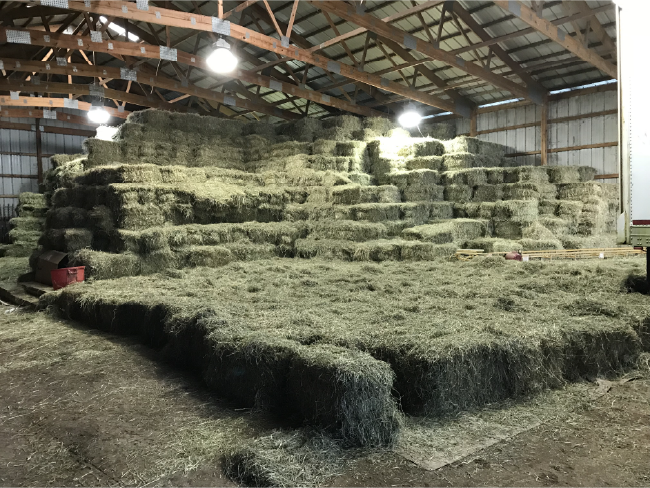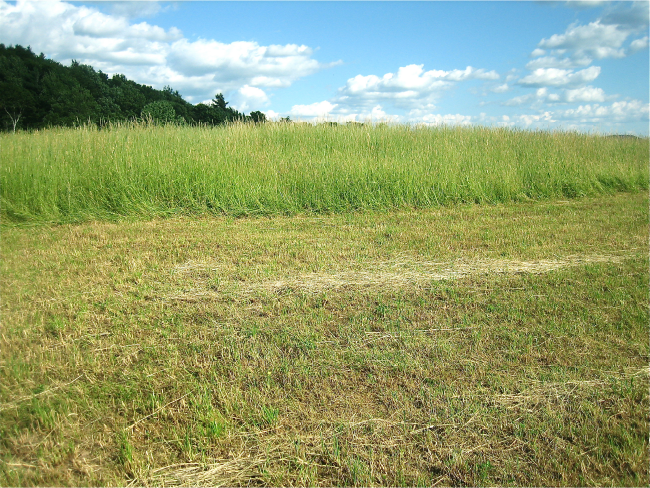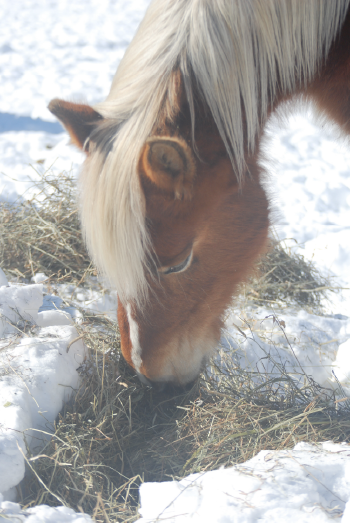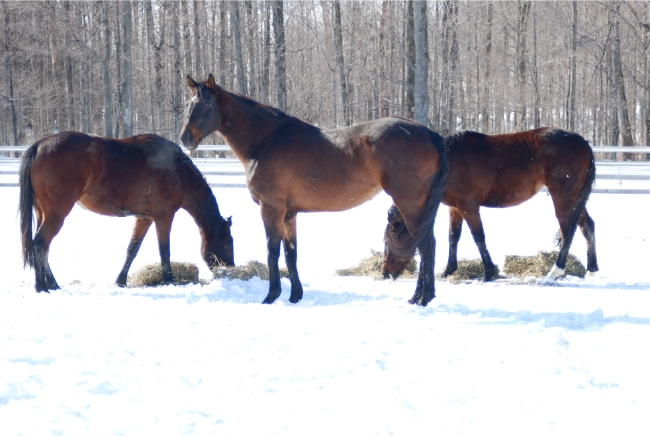Haymaking and Hay Buying For Horses
By CH Staff
If you find yourself bewildered when shopping for good quality horse hay then you are not alone. The myriads of hay bale sizes, shapes and grass types all combine to make horse owners scratch their heads when figuring out the real costs associated with their hay budget.
As farmers figure out the best way to make the most of the hayfield yields, so horse owners combine their knowledge of hay types and experience in managing hay supplies. Then arrives the inevitable handling and storage quandary.
Buying hay by the ton (2000 pounds) sounds an easy way to compare prices but the issue becomes how do you verify the weight of your average humongous sized bale. The small square bale is simple enough to weigh just standing on a bathroom scale, but these big bales are harder to weigh without a warehouse size scale and large equipment.

Additionally weight does not equal quality. A hay bale that weighs a lot can contain a lot of water, and properly cured hay that measures less than 14% moisture content is a must to help mitigate the risk of mold or dust forming in the bales after harvest. How can you possibly ascertain the quality of the hay inside the larger bales?
If you ever unrolled a large round bale or watched a netted or wrapped bale of hay be carpeted across a field on TV, you also know there is likely some mold and wastage involved. Similarly the horses themselves love to utilize any hay provisions as bedding, and seemingly delight in spreading loose hay as far and wide as possible in the field or stall. This causes even more wastage.
Hay containment is a good solution to minimizing this wastage factor at feeding time. However, hay nets set too low on a stall wall or fence are a recipe for disaster. Injuries to various species of the genus Equus occur as a result of hooves/legs caught in hay net holes. Such incidents can cause life-threatening damage to the vulnerable tissues of the unprotected leg.
Hay mangers and haynets should be set high enough not to threaten the horse with injury, but not too high or grass seed and detritus from hay can become a source for eye infections.
Then there is the outside use equine feeders, often homemade creations these feeders may be include issues with construction of too low a roof for the specific horses utilizing it, where a sharp protuberance of metal roofing can also impale the horse’s eye, head or neck.
Cow feeders are renowned for their capacity to cause injury to an equine. From a horse’s shoe becoming caught on the feeder causing the animal to panic, to injuries sustained when halters left on during turnout that become hooked on feeder edges, to Equus jumping inside an empty hay feeder and then rolling and being cast – the cow hay feeder is another recipe for disaster offering at best an expensive vet bill and at worst the real possibility that euthanasia of the animal will be required.

So – what is a horse person to do to assuage these issues and make a good financial decision when buying hay? And if you are making and marketing hay for horses, what can you do to make sure your hay is not just palatable for horses but also budget and use friendly? And how will you move it from A to B, both within the perimeters of the property or barn and from farm to farm?
How do you produce hay without chemical components yet keep the soil balanced and bio-diverse for sustainability and weed control? How do you harvest your hay without preservatives or dry-down agents that may harm the horse’s microbiome and cause digestive issues, heaves and allergic reactions and inflammations?

Hay is a crop. As such growing and harvesting it is subject to a) the weather b) the maturity of the grasses and readiness for optimal harvesting c) insect and wild animal grazing d) contamination by; neighboring farm products such as crop dusting and spraying; foreign objects thrown aside from the roadside users or electric linework leftovers; sticks and fallen boughs from trees; errant weed growth; rocks and stones; insect infestations; wildlife killed by the machine during harvesting such as mice, snakes or fawns.
All this makes you wonder why anyone bothers trying to make horse hay at all. You could simply go to the neighborhood farm shop or shop online and buy sacks of cubes and hay extenders. Trouble is that those products list specific ingredients used as preservatives that it is likely you don’t actually want your horse to eat. Not ideally. It’s worth doing some research before hopping on that train.
 Holistic viewpoints would suggest that a varietal herbal and plant grazing situation can negate the need for dry forage at all. But that’s not true either.
Holistic viewpoints would suggest that a varietal herbal and plant grazing situation can negate the need for dry forage at all. But that’s not true either.
No hay product is going to be perfect. It’s hard to balance the need for good quality hay, avoid possible contaminants and know the provenance of the hay you resource. But this has always been the way of hay.
Errors and omissions will occur during the haymaking process, during the buying process, during the storage process. And even during the feeding process.
At the end of the day most horses won’t eat something that either smells weird, looks out of place, or is dried in the hay that is not grass. Given they have an option and are not starving and super hungry, most Equus will avoid ingesting moldy or weedy product and turn instead to a healthier flake of hay. The composition of chemicals on and in the hay are a bit more difficult for them to ascertain however, so that is notably harder for the horse owner to realize until it is later down the road and signature signs of respiratory inflammation or heaves etc. appear.
Keep a weather eye on all the factors that make up your hay supply. Try and follow the provenance so you can have trust in the producer. If the hay producer is feeding the same hay to their own horses then it is always a good sign that the quality will be there. Likely the main reason they bother with haymaking at all is to produce good quality for their own animals and then sell the overage.
Check hay before you buy it. If you are buying it in on a trailer, check not just the first bale on the tail of the truck, but the ones at the middle and front of the trailer too, in case it is a mixed load from different sources.
Remember most farmers are doing their level best to provide a good product. You do pay more for better quality in hay, just as in most other avenues of life better quality products cost more.
Haymaking is a labor of love for many. And if you can’t do it yourself you have little choice in controlling the end product. You can only do your best and leave your animals to do the rest.





